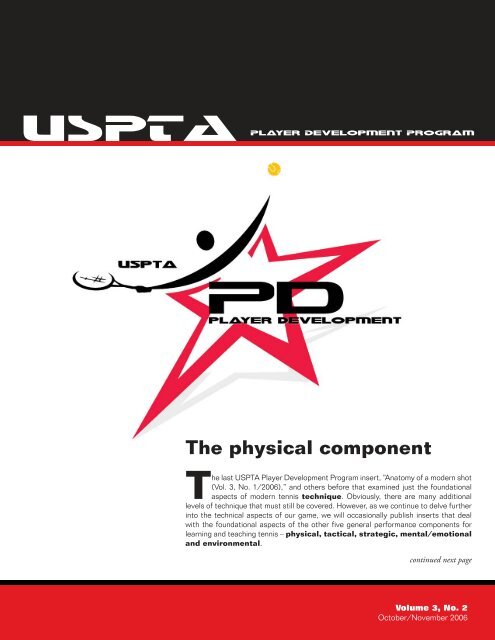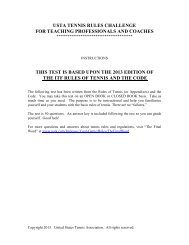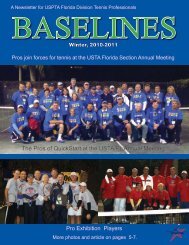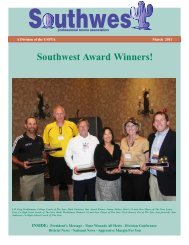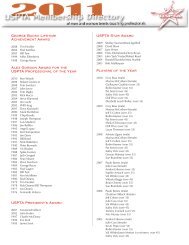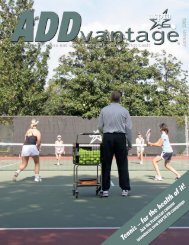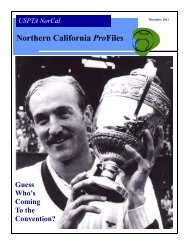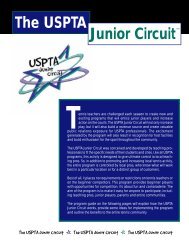The physical component - United States Professional Tennis ...
The physical component - United States Professional Tennis ...
The physical component - United States Professional Tennis ...
Create successful ePaper yourself
Turn your PDF publications into a flip-book with our unique Google optimized e-Paper software.
USPTA Player<br />
Development Program<br />
<strong>The</strong> <strong>physical</strong> <strong>component</strong><br />
<strong>The</strong> last USPTA Player Development Program insert, “Anatomy of a modern shot<br />
(Vol. 3, No. 1/2006),” and others before that examined just the foundational<br />
aspects of modern tennis technique. Obviously, there are many additional<br />
levels of technique that must still be covered. However, as we continue to delve further<br />
into the technical aspects of our game, we will occasionally publish inserts that deal<br />
with the foundational aspects of the other five general performance <strong>component</strong>s for<br />
learning and teaching tennis – <strong>physical</strong>, tactical, strategic, mental/emotional<br />
and environmental.<br />
continued next page<br />
Volume 3, No. 2<br />
October/November 2006
Exhibit I outlines each performance <strong>component</strong> and its defining<br />
concepts. In this insert, we’ll cover the <strong>physical</strong> <strong>component</strong> and<br />
its seven sub<strong>component</strong>s.<br />
<strong>The</strong> USPTA Player Development Program is based on the premise<br />
that it is virtually impossible to isolate the <strong>physical</strong> <strong>component</strong>,<br />
or any one of the six general performance <strong>component</strong>s, from the<br />
others when it comes to diagnosing and solving any problems a<br />
player might have in his or her development.<br />
For example, let’s consider the following case study:<br />
A coach works with a player who regularly starts to cramp<br />
in the third set. <strong>The</strong> coach might first consider the <strong>physical</strong><br />
<strong>component</strong> and its sub<strong>component</strong>s of conditioning, strength<br />
and nutrition to determine the cause for the cramps.<br />
However, because he’s been working with this player for<br />
some time, he also knows the player hits every shot with<br />
excessive energy and motion. This burns energy, fluids<br />
and electrolytes at such a high rate that it’s impossible for<br />
the player to adequately replace them on changeovers or<br />
between sets. <strong>The</strong>refore, the coach may conclude that the<br />
cause of the problem may be technical in nature, and involves<br />
the player’s shot fundamentals, footwork/movement and<br />
modern shot techniques.<br />
To further complicate the situation, whenever the player<br />
gets into a third set, he worries about cramping and talks<br />
about it audibly. <strong>The</strong> stress he places on himself mentally<br />
breaks down his game, creating a connection to another<br />
performance <strong>component</strong> – the mental aspect. <strong>The</strong> coach<br />
may also address the tactical and strategic <strong>component</strong>s in<br />
an effort to teach the player to more effectively use patterns,<br />
shot selection, and game style to reduce the amount of<br />
energy expended during points, games, sets and matches.<br />
Only by addressing all of the separate yet connected issues<br />
will the coach be able to retrain the player using the various<br />
general performance <strong>component</strong>s and their related concepts.<br />
See the graphic on the next page.<br />
In developing this material, we asked members of the USPTA<br />
Player Development Advisory Council if we were oversimplifying<br />
the integration that occurs between performance <strong>component</strong>s by<br />
covering only one at a time. <strong>The</strong> members agreed that although the<br />
relationships between the performance <strong>component</strong>s are impossible<br />
to ignore, separating them for the sake of providing more details<br />
for teachers and students alike is more easily explained and<br />
understood. After we’ve covered all six <strong>component</strong>s, we will tie<br />
them together through more examples and a detailed insert on<br />
periodization.<br />
Exhibit I: General performance <strong>component</strong>s for periodization<br />
Physical Technical Tactical Strategic Mental Environmental<br />
Motor skills<br />
Tracking skills<br />
Consistency<br />
Repetition<br />
Self-esteem<br />
Fun<br />
Conditioning<br />
Racquet skills<br />
Placement<br />
Recognizing<br />
strengths<br />
Confidence<br />
Home<br />
Speed, agility,<br />
quickness<br />
Shot<br />
fundamentals<br />
Patterns<br />
Game style<br />
Independence<br />
Social<br />
Strength<br />
Ball control<br />
Spins<br />
Surfaces<br />
Discipline<br />
Economic<br />
Nutrition<br />
Movement &<br />
footwork<br />
Power<br />
Game<br />
situations<br />
Temperament<br />
Competitive<br />
Flexibility<br />
Modern shot<br />
technique<br />
Shot selection<br />
Match<br />
situations<br />
Concentration<br />
Medical<br />
Developing<br />
weapons<br />
Competitive<br />
situations<br />
Tournament<br />
situations<br />
Goal setting<br />
Developing<br />
game styles<br />
Sportsmanship<br />
2<br />
Competitive<br />
readiness
Technical<br />
• Shot fundamentals<br />
• Movement and<br />
footwork<br />
• Modern shot<br />
technique<br />
Mental/<br />
• Self-esteem<br />
• Confidence<br />
• Temperament<br />
• Competitive<br />
readiness<br />
Player<br />
Physical<br />
• Conditioning<br />
• Strength<br />
• Nutrition<br />
Cramps<br />
Tactical<br />
• Placement<br />
• Patterns<br />
• Shot selection<br />
Strategic<br />
• Game style<br />
• Game situations<br />
• Match situations<br />
Environmental<br />
• Home<br />
Stress<br />
Diet<br />
• Social<br />
Late nights<br />
skipping, running, jumping, pivoting on one foot, changing<br />
direction, throwing and catching. When teaching young players,<br />
such as 3- to 10-year-olds, teachers should incorporate these skills<br />
into lesson plans or the periodization of the players. Many of the<br />
Little <strong>Tennis</strong> lessons available online through USPTA incorporate<br />
these basic skills in weekly lesson plans.<br />
With beginners you may have to be more creative in teaching these<br />
skills (if not already acquired) and incorporating them into your<br />
lesson plan as part of a fun and interactive drill or game. Catching<br />
and throwing may have to be acquired by children as they learn<br />
related tennis skills such as volleys or serves. Overhanded throws<br />
are representative of the serve and overhead shots; sidearm<br />
throws are representative of groundstrokes. <strong>The</strong>re are also<br />
training methods that not only strengthen the core, but also help<br />
with stroke production by getting a player to “feel” how his body<br />
works and also establish a more efficient kinetic chain. Exercises<br />
with a lightweight medicine ball and similar drills can help a player<br />
improve tennis-specific motor skills.<br />
Figure 1: Six performance <strong>component</strong>s play a role in solving<br />
player’s cramping.<br />
<strong>The</strong> <strong>physical</strong> sub<strong>component</strong>s include:<br />
Motor skills, conditioning, speed, agility and quickness,<br />
strength, nutrition, flexibility, medical (see colored boxes<br />
in Exhibit I)<br />
Let’s address each one of the <strong>physical</strong> sub<strong>component</strong>s with<br />
insights from our Player Development Advisory Council and other<br />
resources:<br />
Motor skills<br />
When we speak of motor skills,<br />
we are talking about the skills<br />
that build a foundation for further<br />
athletic success.<br />
This foundation consists of many<br />
skills that are taken for granted,<br />
especially for beginners. <strong>The</strong>se<br />
skills form the basis for not only<br />
success in hitting and playing, but also for the rate of skill<br />
acquisition for these players. <strong>The</strong> required skills include walking,<br />
3<br />
In a recent interview with Jack Groppel, Ph.D., we asked him to<br />
define motor skills for us.<br />
“Gross motor skills really involve very large muscle groups,<br />
for example, running, jumping, and actions that are very large<br />
in nature. Fine motor skills are smaller, for example, such as<br />
carving with a knife. If you’re carving a piece of meat or picking<br />
up marbles with your toes, these are fine motor skills.
From David T. Porter, Ed.D., we learn that tennis is a game of<br />
movement and, as such, is considered an open-skill activity.<br />
This means that the environmental conditions during play are<br />
constantly changing. According to Porter, the most important<br />
motor skills at the earliest stages of learning tennis are<br />
predicting and intercepting. For example, the foot-hand-eye<br />
coordination is crucial in all aspects of learning to play, enjoy<br />
and succeed at tennis.<br />
“Learning to predict where the opponent’s ball will land, based<br />
on speed, spin, trajectory, and height of the ball and where it will<br />
end up are predicting skills,” Porter said. “Intercepting skills<br />
involve moving to the spot where you have predicted the ball will<br />
end up and being there ahead of your opponent’s ball.<br />
“<strong>The</strong>se predicting and intercepting skills are the cornerstone of<br />
efficient stroke technique. This is why students with a wide variety<br />
of athletic skill pick up tennis up much quicker than students with<br />
little movement experience.”<br />
Nick Bollettieri speaks about motor skills in these terms. “Humans<br />
begin their motor skill development very early. However, it takes<br />
years to fully develop and master. We start by learning the basic<br />
skills of human movement and eventually combine those skills<br />
into natural behavior as well as athleticism,” he said.<br />
Coordinating a one-handed backhand involves multiple<br />
motor skills.<br />
“Now, as they relate to tennis, when you’re running to hit a<br />
forehand and you’ve been pulled wide and you’re on a full run<br />
and you’ve got to hit a passing shot down the line, that action<br />
requires a lot of gross motor skills to make the shot and stay<br />
in control. Fine motor skills are different. For example, let’s say<br />
you’re coming in to the net and you’ve pulled your opponent deep<br />
into a corner and the opponent hits a ball crosscourt and you’re<br />
going to hit a really soft drop volley. Now you have to soften<br />
things up a little bit and slow down. In other words, with gross<br />
motor skills, you accelerate a great deal. With fine motor skills,<br />
you start decelerating a little bit, so you can start controlling the<br />
movement a lot more,” Groppel explained.<br />
When coaching the player and these skills, Jack Groppel likes<br />
the theory of “simplest is best.” He explains that the coach should<br />
not only know what to correct, but also be able to communicate<br />
the helpful information in a way that the student does not have to<br />
process or think about it. “It is not in the student’s best interest to<br />
be heavily involved in stroke mechanics. It can create a situation<br />
such as ‘paralysis by analysis,’ which is when the athlete cannot<br />
perform because he is focusing on the ‘how’ of the shot rather<br />
than just executing it. This can lead to athletes who struggle with<br />
their execution during the heat of competition.<br />
“<strong>The</strong> greatest teachers will use ‘cues’ that require no processing<br />
by the student. <strong>The</strong>y are regularly occurring words/statements<br />
that the student grasps easily. For example, to get a young student<br />
to use the legs more, you could say ‘as you toss, sit down.’ <strong>The</strong>y<br />
won’t really sit down, but they will flex the knees and then push<br />
off. <strong>The</strong>re are easy teaching cues for every move in the game. We<br />
as teachers have to be creative to connect with our students,”<br />
said Groppel.<br />
“Specific tennis motor skills consist largely of hand-eye<br />
coordination. <strong>The</strong> various nervous and muscle system functions<br />
synchronize over time to provide the athlete with the ‘feel’ of<br />
tennis.”<br />
When Rick Macci speaks of motor skill development he<br />
emphasizes the importance of having children play all kinds of<br />
sports. “Even simple games such as ‘tag’ will develop the abilities<br />
to run, turn, stop, improvise, create, and will develop overall<br />
coordination. <strong>The</strong> best part is they will be having fun while they are<br />
doing it. Just being outside and playing anything will help develop<br />
motor skills that will carry over to tennis skills,” said Macci.<br />
<strong>The</strong>re are differing schools of thought when it comes to deciding<br />
how a young athlete should be developed. In Bollettieri’s <strong>Tennis</strong><br />
Handbook, writers Istvan Balyi and Ann Hamilton conclude that<br />
the <strong>United</strong> <strong>States</strong> and Canada have been seen in the past as<br />
negligent in teaching the basic motor skills before racquet skills<br />
in tennis. Still there are others who believe in a recreational and<br />
fun atmosphere to first develop a correlation between the activity<br />
and enjoyment. <strong>The</strong>re are still others who believe in an approach<br />
that stresses a variety of different athletic activities before<br />
concentrating on one sport.<br />
What does this mean to you and your players? It means that by<br />
the time players get to you for lessons or formal training, they<br />
might not have developed all their motor skills. <strong>The</strong>se players<br />
could be any age when they come to you. It could be the child in<br />
a class of four kids who hasn’t developed the skills of the others.<br />
It could also be the 40-year-old trying tennis for the first time in a<br />
beginner program. You must be very aware of your player’s motor<br />
skills and be able to help your student improve his basic skills<br />
while still raising his overall comprehension of the other general<br />
performance <strong>component</strong>s as well.<br />
4
Conditioning<br />
<strong>The</strong> Encarta Dictionary lists<br />
conditioning as a “gradual training<br />
process” and this process in our<br />
definition covers many aspects.<br />
<strong>The</strong>se aspects of conditioning are<br />
aerobic conditioning, anaerobic<br />
conditioning, conditioning for<br />
strength, and conditioning for<br />
movement/speed, etc. <strong>The</strong><br />
conditioning for strength, movement and speed will be covered in<br />
their respective sections of this document. For now, we will focus<br />
on the aerobic and anaerobic training of a tennis player. Even<br />
though we are covering these two types of conditioning under the<br />
same heading, they are vastly different from each other.<br />
<strong>The</strong> importance of conditioning is stressed by the information<br />
we received from Nick Bollettieri. “<strong>Tennis</strong> can be considered<br />
an intermittent anaerobic sport with a large demand on a<br />
cardiovascular base. Typically points range between three and<br />
10 seconds, with an average of four to five seconds. <strong>The</strong> area<br />
tennis players cover per point is generally 8 to 12 meters or 10<br />
to 15 yards. Considering the short breaks in between points,<br />
games and the overall duration of match time, which reaches<br />
into the hours, the demand for the successful athlete to be highly<br />
conditioned is clear,” Bollettieri said.<br />
Both aerobic and anaerobic conditioning is necessary for tennis<br />
and they need to be addressed in a player’s training program<br />
whether she is a weekend warrior, aspiring junior or tour player,<br />
according to Bollettieri.<br />
Your body gets its energy from two sources. In Paul Roetert and<br />
Todd Ellenbecker’s Complete Conditioning for <strong>Tennis</strong>, we find<br />
definitions for aerobic and anaerobic and how the source of<br />
energy determines the definition.<br />
Aerobic – means needing oxygen to take place. Aerobic activity<br />
includes longer duration and steady-paced movements that<br />
require the body to receive energy from burning carbohydrates<br />
and fats using energy pathways that include oxygen.<br />
Anaerobic – means not needing oxygen to take place.<br />
Anaerobic activity includes high-intensity, short-duration<br />
events that use stored energy in the muscles or energy made<br />
rapidly when you initiate the activity.<br />
Let’s look at how aerobic and anaerobic conditioning are<br />
related.<br />
Complete Conditioning for <strong>Tennis</strong> by Roetert and Ellenbecker<br />
explains how both anaerobic and aerobic conditioning is important<br />
in tennis. It says, “An average point even on a clay court, probably<br />
won’t last more than 10 seconds. During this time, you may have<br />
as many as four or five direction changes. Following a point you<br />
will have a maximum (play to the pace of the server) 25-second<br />
rest period and on the changeovers a 90-second rest period.<br />
This clearly makes tennis an anaerobic sport, requiring agility<br />
and speed. However, a tennis match can last as long as three<br />
hours. <strong>The</strong>refore, aerobic conditioning and muscular endurance<br />
come into play as well. Having a good aerobic base will help you<br />
recover between points, and muscular endurance will improve<br />
Cardio <strong>Tennis</strong> provides a tennis-specific way to train the aerobic and anaerobic system.<br />
5
muscle strength and may correct muscle imbalances from the<br />
one-sidedness of tennis. Clearly to be a good tennis player, you<br />
need a properly designed, tennis-specific training program.”<br />
Groppel says, “Depending on the skill level and the aspirations<br />
of your students, you need to determine if you are using tennis to<br />
help them get fit or if they need to get fit to play tennis. As they<br />
climb the competitive ladder, they must get fit to play tennis. <strong>The</strong><br />
foundation must be sound aerobic fitness to give them endurance<br />
and to help them recover between points. It could take at least<br />
four to six weeks to develop this foundation. <strong>The</strong>n, they can go<br />
into tennis-specific training to achieve high levels of anaerobic<br />
fitness, including speed and power. Next, strength is critically<br />
important. Muscular strength and endurance will play a large role<br />
in shot execution, court coverage and endurance to play the long<br />
matches. Flexibility, or range of motion, becomes increasingly<br />
more important as the player improves her ability level.”<br />
Porter suggests working conditioning into your student’s training<br />
schedule. “Once an overall cardiovascular base is established,<br />
conditioning most often becomes sport specific. <strong>Tennis</strong> is certainly<br />
an example of this,” he adds.<br />
“Conditioning for tennis should include explosive movements<br />
over relatively short distances with emphasis being placed on<br />
maintaining appropriate balance. This almost always involves<br />
changing directions.<br />
“Utilize games and drills that most closely resemble actual playing<br />
situations. At the early stages this may mean designing on-court<br />
games using racquets that challenge a player’s ability to work<br />
when tired.<br />
“At the higher levels this means creating a workload that places<br />
a player in oxygen debt (oxygen requirements are greater than<br />
a player’s ability to replace used oxygen) and then training at<br />
that level. This ultimately will increase what is referred to as the<br />
anaerobic threshold or the place where the workload challenges<br />
both the physiological and psychological peaks. Gradually<br />
increasing this threshold will give a player both a <strong>physical</strong> and a<br />
mental advantage in competition,” Porter says.<br />
What about all those drills and examples for your lessons? You<br />
probably already know many and have included them in your<br />
lessons. It would be impossible to include all the examples of<br />
conditioning in this small space, so if you need more, we will<br />
direct you to one of the best resources we used for this insert.<br />
We recommend Complete Conditioning for <strong>Tennis</strong> by Roetert<br />
and Ellenbecker. This book not only contains many drills and<br />
overall guidelines for all areas of the <strong>physical</strong> <strong>component</strong>, but<br />
also is very comprehensive and is a great starting point for<br />
building your expertise in this area.<br />
Speed, agility, quickness<br />
<strong>The</strong> USPTA Player Development<br />
Program has grouped speed,<br />
agility and quickness into<br />
the same sub<strong>component</strong> to<br />
keep related sub<strong>component</strong>s<br />
together. Each one of these is<br />
important unto itself and could<br />
be addressed as a separate<br />
sub<strong>component</strong> of the <strong>physical</strong><br />
performance <strong>component</strong>. With that in mind, we will separate<br />
these for our discussion.<br />
Some of the best definitions for each of these come from the<br />
Nick Bollettieri <strong>Tennis</strong> Academy Group, which contributed<br />
valuable information to this insert. <strong>The</strong> group’s insights are<br />
as follows.<br />
Speed, agility and quickness are interrelated <strong>component</strong>s of<br />
movement. <strong>Tennis</strong> players with good movement have strong<br />
skills in each area.<br />
Speed can be considered movement of the limbs as fast as<br />
possible in order to propel the body forward in a straight line.<br />
“Physical conditioning is a true separator. Andre Agassi was<br />
quoted as saying that mental toughness is very important but<br />
that it didn’t matter how strong your mind was, if your body won’t<br />
back it up, forget it.”<br />
How does this apply to your weekly lessons? As a complete<br />
professional you must ask questions of your players to find out<br />
what their goals are. <strong>The</strong>re is not a single case where some sort<br />
of conditioning would not benefit a player at any age or level.<br />
From a junior perspective, it is imperative young players work<br />
on their conditioning and not just “hit balls.” <strong>The</strong> comprehensive<br />
professional helps his students by guiding them and recommending<br />
conditioning exercises to help enhance their performance.<br />
From the perspective of an adult beginner or intermediate player,<br />
staying fit is one of the reasons for playing tennis. By incorporating<br />
conditioning into even 10 percent of a lesson, you can make a<br />
positive impression on your player and also add more variety to<br />
your lessons. Your commitment to conditioning may allow you to<br />
differentiate yourself from other teaching pros.<br />
6
Enhancing quickness and agility enables a player to cover all parts of the court for better performance.<br />
An example of speed is the act of getting to the opponent’s<br />
dropshot when a player starts from behind the baseline.<br />
Agility is the ability to change direction quickly with balance and<br />
control. In tennis, agility particularly applies to all directions of<br />
movement. A common example is when a player moves back<br />
and forth along the baseline and adjusts with the depth of shots<br />
she receives. A better example is the player’s ability to move<br />
back to hit a shot and while recovering, change direction and<br />
move diagonally forward to cut off the short ball. Having good<br />
agility provides the player with an advantage by providing the<br />
opportunity to get into position and implement the technique of<br />
the selected stroke.<br />
Quickness involves the ability to react to visual, auditory and<br />
kinesthetic (body awareness) information. Quickness involves a<br />
subconscious decision-making process that invokes speed and<br />
agility. <strong>The</strong> return of serve best exemplifies quickness in tennis.<br />
“Agility, quickness, speed, coordination and dynamic balance are all<br />
critical <strong>component</strong>s of being a good tennis player,” said Groppel.<br />
“An athlete’s first step can be developed and experiences can<br />
be created to help the athlete ‘learn’ anticipation skills on the<br />
court. Quickness is all about the first step. If you show me a<br />
player with a slow first step, I will show you a slow tennis player.<br />
Practice sessions can be designed to help the individual work on<br />
‘emergencies’ and practice being in a balanced state during an<br />
unbalanced situation. When I have worked with players in this area,<br />
I always highlighted the 3 R’s – ready, read, react and then explode<br />
to the ball. I used drills using z-balls, hexagon jumping drills, ball<br />
reaction drills, etc., to teach all the movement principles,” Groppel<br />
explains.<br />
“Speed, agility and quickness in tennis all relate to a player’s ability<br />
to recognize the need to move, to start early (quickness), to get<br />
to a designated spot in as short a time as possible (speed), and<br />
to do so while maintaining balance even when changing directions<br />
(agility),” adds Porter.<br />
“Although these skills are somewhat limited by genetics, training<br />
can help immensely. Speed, agility and quickness should be<br />
emphasized early in development with drills as simple as catching<br />
with the hands on the hips, the eight-ball drill, and/or the check<br />
drill. (See the “On Court with USPTA” episode “Footwork for the<br />
open-stance forehand and backhand.”) Each of these drills on<br />
DVD combines all three skills and rewards a player who develops<br />
the ability to make a good first step,” said Porter.<br />
Macci emphasizes developing the athlete in your students to<br />
create better skills. “Make your player the best athlete he can be.<br />
<strong>Tennis</strong> is so athletic and getting more and more so every day. <strong>The</strong><br />
best players will be the best athletes. By being better athletes,<br />
the players will have better body control and balance and be able<br />
to improvise their movement on the court to create situations that<br />
will lead to success. Movement is key; it is one of the ‘X factors,’<br />
the ultimate variable in today’s game, as it allows you to play both<br />
offense and defense and gives you a chance at any point because<br />
you can get to the ball,” he said.<br />
7
In other words, it is speed applied to strength and we see this as<br />
the explosiveness of a muscle or muscle group when in action.<br />
Training for tennis must include the aspect of power.<br />
Porter explains power as “a combination of speed and strength.”<br />
He believes players should participate in overall body strengthening<br />
programs, in addition to tennis-specific activities, that develop<br />
muscular areas most often used in tennis, such as legs, the core<br />
and shoulders.<br />
Nick Bollettieri has divided the sub<strong>component</strong> of strength into<br />
five focus areas: relative, optimal, endurance, speed, and<br />
stabilization and core strength. Breaking them down helps him<br />
define what he is looking for and helps him evaluate a player. <strong>The</strong>se<br />
terms are provided as a form of reference for you, however, not<br />
all of these terms are scientific. <strong>The</strong>y are words used to define<br />
some aspect of strength or power.<br />
<strong>The</strong> speed ladder can be a great tool for agility training.<br />
How can you apply speed, quickness and agility training to<br />
your teaching? Just as with conditioning and even as part of<br />
conditioning, you can and should incorporate quickness and fitness<br />
drills into your lessons. <strong>The</strong> great thing about these skills is that<br />
they are directly related to conditioning and you can tailor your<br />
conditioning for your players directly to their speed, agility and<br />
quickness drills. Remember to consider the work-to-rest ratios of<br />
a tennis point and the fitness level of your students.<br />
Strength<br />
Strength is defined as the maximum<br />
amount of force a muscle can<br />
produce. <strong>The</strong> sub<strong>component</strong> of<br />
strength in the Player Development<br />
Program includes not only the base<br />
definition of strength, but also all<br />
the related areas of strength that<br />
teaching professionals and coaches<br />
must know.<br />
<strong>The</strong> Nick Bollettieri definition of strength is the ability to exert force<br />
against an external resistance. In tennis, strength is demonstrated<br />
when a player exerts force into the ball and into the ground to<br />
produce body movement. <strong>The</strong>re are various types of strength. In<br />
tennis the most important types of strength are:<br />
• Relative strength: This is the amount of force that can be<br />
produced relative to one’s body weight. Lighter people who<br />
are relatively strong typically move better and have good<br />
levels of conditioning.<br />
• Optimum strength: Optimum strength refers to the ability to<br />
generate the right amount of force at the right time. This is<br />
important for tennis strokes due to time sensitivity and force<br />
production.<br />
• Endurance strength: <strong>The</strong> ability to produce and maintain<br />
force over a prolonged period of time is a definite requirement<br />
when a match goes into the fifth and deciding set.<br />
• Speed strength: Speed strength is closely related to<br />
movement and is another term for power. It is the ability to<br />
exert force as fast as possible. <strong>The</strong>re are several variations<br />
of speed strength – starting strength, explosive strength<br />
Strength is an integral part of a tennis player’s development for<br />
many reasons. <strong>The</strong>y need to have muscular strength to not only<br />
execute the movements and striking motions that go into hitting<br />
a tennis ball, but also to propel their bodies to get into position to<br />
hit a tennis ball. Strength also significantly helps an athlete in his<br />
ability to accommodate all the force he creates and encounters<br />
while playing. And, strength is especially important in preventing<br />
injuries.<br />
Since tennis demands a player to repeat powerful actions over a<br />
long period of time, a player needs to have muscular endurance<br />
as well.<br />
But strength without the ability to quickly summon that force is<br />
not very useful for a tennis player. That is why power must be<br />
covered and needs to be defined under this topic. We know that<br />
power in a scientific sense is the amount of work per unit of time.<br />
Adam Brewer with various training aids.<br />
8
carefully selected and timed diet can make the difference between<br />
“feeling good” and “feeling great.”<br />
We interviewed Groppel recently about the topic of nutrition and<br />
he offered the following: “An athlete needs a well-balanced diet,<br />
consisting of proteins, carbohydrates and fats. Water is a critically<br />
important nutrient that must be consumed at regular intervals.<br />
<strong>The</strong> other important nutrients include vitamins and minerals,<br />
which should be found in the normal, daily consumption of foods<br />
in a well-rounded diet. Athletes should always consider how their<br />
diet varies, the portion sizes consumed, and the timing of when<br />
and how to eat.<br />
and reactive strength. <strong>The</strong> ability to start movement quickly<br />
(starting strength) can be seen in the initiation of the return<br />
of serve or getting to the dropshot. Generating power<br />
for a serve or groundstroke requires explosive strength.<br />
Changing directions rapidly in a baseline rally relies heavily<br />
upon reactive strength. Speed strength is arguably the most<br />
important form of strength for high-level tennis.<br />
• Stabilization and core strength: <strong>The</strong>se forms of strength are<br />
essential for the development of any athlete. It is important<br />
to develop and maintain stability and core strength in order<br />
to sustain the correct body position during movement. Doing<br />
so will help prevent injury and allow the body to handle the<br />
various levels of force that it absorbs and produces.<br />
<strong>The</strong> need for core strength is emphasized by Groppel. “In the early<br />
1980s, one of my graduate students, Ann Quinn, Ph.D., who went<br />
on to coach Pat Cash and Pat Rafter in their fitness, studied this<br />
and saw that, even on the volley, the abdominals contracted at<br />
over 50 percent of their maximum.”<br />
Before going further, we must impress upon you that any off-court<br />
strength training program should be developed by a certified<br />
trainer and done with his or her exacting standards of form and<br />
balance.<br />
Nutrition<br />
Although we plan to include the<br />
topic of nutrition in a separate<br />
insert, we also wanted to include<br />
it in this insert as a part of the<br />
<strong>physical</strong> <strong>component</strong>.<br />
To Nick Bollettieri, nutrition<br />
is an important part of overall<br />
development. “Nutrition is essential<br />
to providing the fuel for the machine that is the human body.<br />
High-level training and competition places huge demands upon<br />
the various systems of the body. Optimal nutrition is essential<br />
to replace the supplies used up in the demands of each day. A<br />
“I believe you have to look at nutrition in two ways. <strong>The</strong> first is<br />
to view food as fuel. <strong>The</strong> body needs fuel for sustenance. <strong>The</strong><br />
second way you should view food – and I don’t want to sound<br />
facetious in saying this, but – you should almost look at food as<br />
a drug. You see, food changes your body chemistry. When you<br />
eat, hormones are affected, blood glucose rises, and on and on.<br />
At the Human Performance Institute, we believe that food can<br />
either help or hinder your performance. <strong>The</strong> key point to observe<br />
is that you don’t have to become a ‘health nut’ but you do have<br />
to understand how your nutrition choices, as well as the timing of<br />
your meals and snacks, affect your <strong>physical</strong>, emotional and mental<br />
performance,” Groppel said.<br />
“I always consider how you are ‘fueling’ your body to perform<br />
at the highest level possible. This is an effective approach with<br />
which to begin, without going into too much depth. <strong>The</strong> most<br />
simplistic way to look at food is as fuel. <strong>The</strong> best word picture is<br />
to study how a person reacts when he does not eat well. If you<br />
go more than four hours without food, blood sugar drops and you<br />
can become impatient, irritable and lose focus. If you overeat, you<br />
become sluggish and fatigued. When you eat strategically, you<br />
have more energy, your metabolism gets a boost and you truly<br />
can get into a state of high positive energy,” Groppel adds.<br />
“To give you an example, let’s say you eat a well-balanced<br />
breakfast at 7 am. Your glucose levels rise and you feel pretty<br />
good. If you haven’t eaten anything by 11 a.m. (four hours later),<br />
your blood sugar levels will be in a depressed state and you will<br />
easily become irritable and impatient. However, if you eat a small<br />
strategic snack about three hours after the breakfast, you will<br />
stabilize your blood sugar and it will not drop into a depressed<br />
state. And, although this is the “cliff notes” version of strategic<br />
eating, you can maintain high levels of energy if you eat at<br />
strategic intervals throughout the day. <strong>The</strong>re is much more to<br />
this that we will cover in a dedicated section on nutrition,” said<br />
Groppel.<br />
According to Groppel, when it comes to snacking, people must<br />
be aware of the glycemic index of food. <strong>The</strong> higher the glycemic<br />
index, the faster the spike in blood glucose levels. <strong>The</strong> faster<br />
the rise in blood glucose, the faster that insulin is released<br />
from the pancreas to stabilize blood sugar and the quicker a<br />
person enters a state of hunger. However, if a person eats a<br />
low glycemic food (one that has protein, fat or fiber), the rise<br />
in blood sugar is much slower and the longer the glucose level<br />
will be sustained. Eating low glycemic foods such as nuts or<br />
raw fruits and vegetables makes the release in blood sugar<br />
optimal.<br />
9
“Flexibility training is often the most overlooked and least<br />
applied <strong>component</strong> in a quality conditioning program. Some<br />
reasons for this include:<br />
• Stretching doesn’t feel good<br />
• Flexibility’s benefits on the court are not obvious to the<br />
player<br />
• Most players have no specific, individual guidelines for<br />
how, why, what, and when to stretch; and<br />
• Flexibility receives less emphasis by coaches than other<br />
<strong>component</strong>s of conditioning<br />
Eat your veggies!<br />
“<strong>The</strong> final point to make for an athlete is to never experiment<br />
with foods on match day. On the day of competition, players<br />
want to eat foods that they are comfortable with and that they<br />
“feel” will help them,” Groppel explains. “Yes, the psychological<br />
implications of eating are important to consider. Here are two<br />
different examples. Physiologically, there are players who love to<br />
drink orange juice on noncompetitive days but, when they are in<br />
a tournament and feeling a little nervous, the acid in the orange<br />
juice might upset their stomachs. Consider the psychological<br />
implications if you force your players to eat foods they don’t<br />
like, even if it will help them. <strong>The</strong>y have to believe that the<br />
foods will help them.<br />
“If you and your players want to understand how food will<br />
help and the players are willing to try different ‘pre-match’<br />
foods, do it on days when they will be under ‘some’ pressure,”<br />
Groppel suggests. <strong>The</strong>ir body is their laboratory and they want<br />
to experiment with how various foods will work for them on<br />
nonmatch days.”<br />
Groppel believes the principles of nutrition not only enhance the<br />
tennis play of your students, but also are quality-of-life issues for<br />
them, you or anyone. Good nutrition isn’t just about the high-level<br />
athlete, it is for everybody. “If your body has the right fuel at the<br />
right times and has the necessary rest to recover, your quality of<br />
life becomes better,” he says.<br />
Flexibility<br />
On the topic of flexibility, Porter<br />
suggests, “Flexibility is essential<br />
for two very important reasons.<br />
First, it can lessen the risk of<br />
injury. Second, it can allow for<br />
a faster muscular contraction<br />
and, therefore, produce more<br />
power.” <strong>The</strong> perfect introduction<br />
for flexibility comes to us from<br />
Complete Conditioning for <strong>Tennis</strong>, which states:<br />
We define flexibility as the degree<br />
to which the muscles, tendons,<br />
and connective tissue around<br />
the joints can elongate and<br />
bend. <strong>The</strong>re are several types<br />
of flexibility. Static flexibility<br />
describes the amount of motion<br />
you have around a joint or series<br />
of joints while at rest. Dynamic<br />
flexibility refers to the active<br />
motion about a joint or series<br />
of joints and represents the<br />
amount of movement a player has<br />
available for executing serves,<br />
groundstrokes, and volleys.<br />
Dynamic flexibility is limited by the resistance to motion of<br />
the joint structures (bones and ligaments); the ability of the<br />
soft connective tissues to deform (muscles and tendons);<br />
and neuromuscular <strong>component</strong>s of the body which include<br />
nerves.”<br />
<strong>The</strong>re are many factors influencing flexibility including heredity,<br />
neuromuscular <strong>component</strong>s, and tissue temperature. <strong>The</strong> most<br />
applicable factor to you as a tennis-teaching professional is<br />
tissue temperature. Heat increases the elongation and bending<br />
properties of soft tissue. Warming up before stretching by raising<br />
the body’s core temperature or by breaking a light sweat will give<br />
you greater gains in flexibility, with less microtrauma to the tissues<br />
you are stretching.<br />
<strong>The</strong>re are generally three types of stretching: ballistic, static,<br />
and dynamic. Ballistic is the type of quick bouncing at the joint<br />
or motion extremes. Since this is potentially harmful and provides<br />
no significant benefits over the other techniques, we do not<br />
recommend ballistic stretching.<br />
Static stretching involves slow, isolated, smooth movements<br />
and passively holding the extreme range. This type of stretching<br />
is highly recommended as it is the most practical and effective<br />
method and can improve flexibility safely. Done correctly, it<br />
requires little energy, creates minimal danger and no soreness,<br />
and it is best after playing.<br />
Dynamic stretching is another recommended type of stretching<br />
and is effective before playing. Dynamic stretching simulates<br />
the movements of tennis without the stresses of weight bearing<br />
10
in a player’s ability to stay injury free and develop a body, skills<br />
and game plan geared toward success on the court.<br />
Preventing injuries requires a multifaceted approach involving all<br />
of the sub<strong>component</strong>s in the <strong>physical</strong> development of an athlete.<br />
Most experts will agree that the best way to prevent injuries is<br />
to develop sound motor skills, strive for an optimally conditioned<br />
body, increase speed, agility and quickness, build strength,<br />
practice good nutrition, and maintain flexibility.<br />
“Specific programs for increasing flexibility and strength are<br />
staples of injury prevention,” said Jack Groppel, a fellow in the<br />
American College of Sports Medicine. “Appropriate training helps<br />
players reduce the potential for overuse or other types of sportsrelated<br />
injuries.”<br />
or impact. <strong>The</strong> body actively goes through the motions under<br />
control, gradually increasing and exaggerating the size of<br />
the flowing motions. We have included the table below from<br />
Complete Conditioning for <strong>Tennis</strong> for information on dynamic<br />
stretching.<br />
Incorporating Stretching into <strong>Tennis</strong><br />
1. General body warm-up (three to five minutes) to increase<br />
tissue temperature (slow jog, jumping jacks, etc.)<br />
2. Static stretching of tight and restricted areas.<br />
3. Dynamic stretching with progressive increases in range<br />
and velocity of movements.<br />
4. Playing tennis.<br />
5. Static stretching cool-down to prevent muscle soreness<br />
and gain flexibility.<br />
As stated earlier, flexibility is an important part of the <strong>physical</strong><br />
<strong>component</strong> and one of the most overlooked. In future inserts we<br />
will cover flexibility as a separate insert and include flexibility<br />
exercises for tennis.<br />
Medical<br />
<strong>The</strong> medical <strong>component</strong> of a player<br />
development program involves<br />
both preventative and curative<br />
measures.<br />
Prevention is perhaps the most<br />
important issue in the <strong>physical</strong>medical<br />
<strong>component</strong> for learning<br />
tennis. If coaches and players can<br />
successfully practice prevention, they will not have to resort to<br />
emergency treatments, cures and even rehabilitation that can<br />
interfere with a player’s competitive goals and, ultimately, a<br />
tennis career.<br />
So, a tennis-teaching professional’s main focus should be on the<br />
prevention of injuries, since he or she can make a huge difference<br />
Beyond specific training, it is common sense, Groppel says.<br />
“<strong>The</strong>re’s no reason to do things that will increase your risk for<br />
injury. For example, don’t jump the net.” He also suggests that<br />
teachers and parents work together to emphasize safety on and<br />
off the court since most injuries occur at home and often during<br />
mundane tasks or just plain horseplay.<br />
Injury prevention must become a state of mind with every serious<br />
play since many injuries occur with a senseless act that a conscious<br />
mind could always avoid.<br />
Of course, even the best training cannot prevent accidents or the<br />
overuse that results in injuries. For this reason, tennis teachers<br />
must understand curative measures, including basic first aid<br />
for treating player injuries. See “Tips for injury treatment” on<br />
Page 12.<br />
<strong>The</strong> majority of tennis injuries are the result of overuse from<br />
repetitive stress and minor traumatic events, such as the effects<br />
on the shoulder after serving thousands of times or the injuries to<br />
knees after playing hundreds of points with pivots, turns, twists<br />
and aggressive stops and starts. Overuse injuries occur because<br />
tennis players exert and produce repetitive forces that cause minor<br />
traumas and tissue breakdown.<br />
To cure injuries, tennis teachers must know that they fall into two<br />
categories – acute and chronic – that require different curative<br />
responses. An acute injury is a new injury or a complaint from<br />
the time it occurs and the short time that follows its start. An<br />
example of an acute injury suffered by many tennis players is<br />
an ankle sprain. A chronic injury typically recurs or repeats itself<br />
due to continued play or lack of proper rehabilitation. An example<br />
of a chronic tennis injury is tennis elbow that is present for one<br />
or two years and flares up during long, grueling tournaments.<br />
Acute tennis injuries are much easier to treat, and when treated<br />
promptly and properly, you can prevent an acute injury from<br />
becoming chronic.<br />
According to Nick Bollettieri, world-renowned tennis coach, people<br />
concerned with their own health should surround themselves with<br />
the right team of professionals. “Ideally, the medical team around<br />
a high-level tennis player should rarely be noticed but always<br />
exert its influence. <strong>The</strong> team’s control of injury prevention via<br />
corrective exercise, general body maintenance and short-term<br />
11
Tips for injury treatment – the “PRINCE” ciple<br />
Initial treatment – the first 24 hours following an acute soft<br />
tissue injury are the most important. Injured tissue usually<br />
means injured blood vessels. When blood accumulates<br />
and causes swelling and compression around adjoining<br />
tissue, the lack of blood flow can cause further damage. As<br />
swelling and pressure increase, it can inhibit the healing of<br />
the tissue and cause pain and muscle spasm and decreased<br />
use. <strong>The</strong>refore, every effort should be made to reduce the<br />
amount of bleeding at the site of the injury. Following the<br />
guidelines listed below will help ensure that you treat the<br />
injury properly.<br />
Todd Ellenbecker checks an athletes range of motion in her shoulder.<br />
attention to minor issues hopefully will help a player avoid time<br />
away from competition. However, the law of averages dictates that<br />
occasionally significant health problems will arise. When they do,<br />
a certified athletic trainer, sport <strong>physical</strong> therapist and physician<br />
form the basis of a solid medical team. Bollettieri adds that it is<br />
important to develop a relationship with these professionals prior<br />
to the need for treatment.<br />
A tennis teacher must always be conscious of the <strong>physical</strong><br />
<strong>component</strong>, whether he or she is hitting with a student, using<br />
dead-ball feeds or overseeing an intense workout. Regardless<br />
of a student’s age or skill level, it is vital for a teacher to assess<br />
the player’s activity level and overall condition. Inquire about any<br />
health issues that may put him or her at risk on the court, and if<br />
there’s any doubt about a student’s <strong>physical</strong> condition, limit the<br />
intensity level of any activity.<br />
After sufficient evaluation of a student’s <strong>physical</strong> condition, a<br />
teacher should be able to design a training regimen that mixes<br />
common sense and sound medical knowledge to create a program<br />
that is both enjoyable and educational for a player.<br />
References<br />
• Complete Conditioning for <strong>Tennis</strong>, Paul Roetert, Ph.D., and<br />
Todd S. Ellenbecker, MS, PT, SCS, OCS, CSCS<br />
• Fit to Play <strong>Tennis</strong>, Carl Petersen and Nina Nittinger<br />
• Sports Medicine Specialty Course PowerPoint presentation,<br />
2004 World Conference, Todd Ellenbecker<br />
• “Strength and Conditioning for Injury Prevention and<br />
Performance” PowerPoint presentation, 2004 USPTA<br />
Competitive Player Development Conference, Scott<br />
Riewald<br />
P – Protect. Protect the site from further injury or<br />
aggravation. This may range from protective taping<br />
and bracing to orthotic devices to more stable shoes.<br />
R – Rest (complete or modified). Depending on the severity<br />
of the injury, you may need to have complete or modified<br />
rest. Moving the injured part may result in increased<br />
bleeding and swelling. In more serious injuries, the<br />
injured part may need to be rested completely with<br />
the use of crutches for the lower extremity or a sling<br />
for the upper extremity.<br />
I – Ice. Applying ice or cold packs minimizes pain and<br />
causes a local vasoconstriction, thus reducing bleeding<br />
and swelling by reducing blood flow to the injured area.<br />
Pain is decreased due to the numbing effect of the cold.<br />
<strong>The</strong> cold may also decrease inflammation and muscle<br />
spasms.<br />
N – Nonsteroidal anti-inflammatory. This medication, taken<br />
under a physician’s supervision, can be effective in<br />
decreasing inflammation and pain and thus speed the<br />
healing process. Other-over-the counter remedies<br />
such as ibuprofen can also be helpful (speak to your<br />
physician).<br />
C – Compression. External compression with a firm<br />
bandage helps decrease the amount of bleeding and<br />
swelling into the injured area. Using a tensor bandage,<br />
begin wrapping below the injured area and work<br />
upwards, unwinding the bandage evenly without too<br />
much tension and overlapping the layers by half. Using<br />
compression during and after the application of ice will<br />
improve its effectiveness. [Do not apply ice or compression<br />
if you have circulatory problems or trouble distinguishing hot<br />
from cold.]<br />
E – Elevation. Elevating or raising the injured area reduces<br />
blood flow to the area and encourages venous blood<br />
flow away from the injury. Raising an upper extremity<br />
above the heart and a lower extremity above the pelvis<br />
helps prevent swelling and aids in draining the swelling<br />
into large blood vessels.<br />
12


